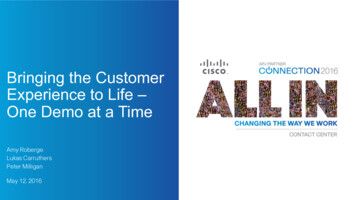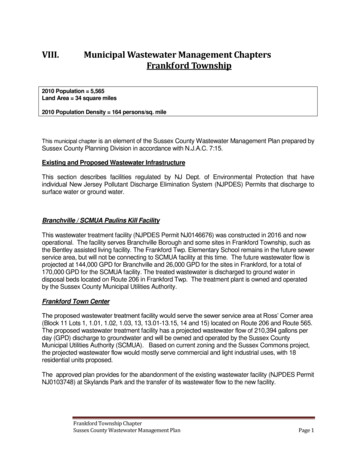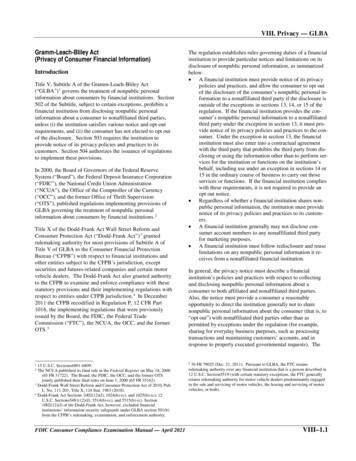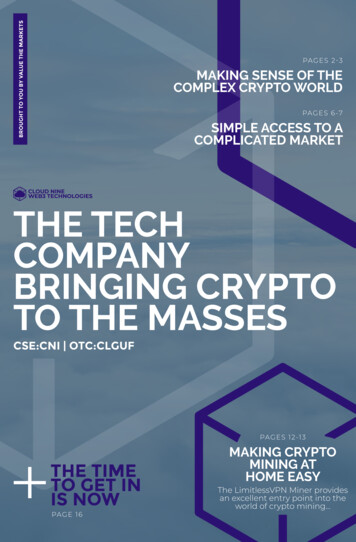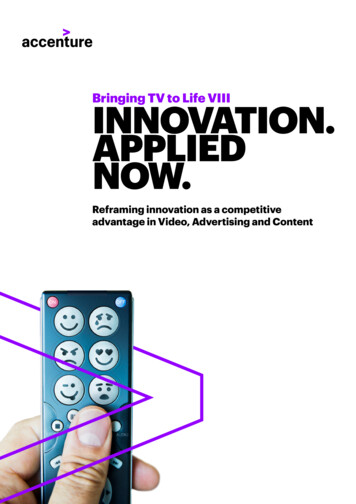
Transcription
Bringing TV to Life VIIIINNOVATION.APPLIEDNOW.Reframing innovation as a competitiveadvantage in Video, Advertising and Content
Contents03 Unlock your potential06 Back to the future10 The innovation opportunity15 A framework for innovation19 Product innovation22 Engineering innovation26 Operating Model innovation28 Commercial innovation31 Ecosystem innovation34 Bringing it all togetherBRINGING TV TO LIFE VIII: INNOVATION. APPLIED NOW. 2
UNLOCKYOURPOTENTIAL
In a world of contradictions, innovationis the key both to transforming your corebusiness and positioning for the new.Content is king.Content is acommodity.Bundled video products are a cost center.Bundled video is the essential differentiatorof any connectivity product.OTT companiesare friends.OTT companiesare enemies.Conflicting opinions thrive in our market.Debates around digital video, its benefitsand its drawbacks, push large playersto seek differentiation in a value chainbuffeted by digital disruption. How doyou continue to benefit from your corebusiness while preparing yourself forthe new? Even if the new model doesn’tmake up for the decline in (or worse,cannibalizes) your core? Stuck betweenproverbial rocks and hard places,dichotomies are expected. It takes verycareful navigation to continue buoyingyour traditional business while exploitingadvantages to set new foundations forinnovations and competition in completelydifferent business models.In BTTL VI and VII we described howthe video market is changing andgave practical, executable insights onhow digital businesses can adapt. Weintroduced the S-curve framework foryour transformation: an approach whereinvestments that drive growth in corerevenue models also underpin emergingdigital ones. We surmised that this waspossible only by unlocking innovationand exploiting trapped value in yourcurrent organization, decoupling fromlegacy operating models and systems.By doing this, video businesses canaugment their existing advantages withenterprise intelligence, enabled by data.This is an operating model that promotesthe integration of cross-disciplinedcapabilities, and a methodology that allowsfor agile, attributable decision making.In this issue of Bringing TV to Life, wedig deeper into why innovation remainsessential to your success, and how you canembrace the latest ideas to keep it alivein your products, engineering, operatingmodel, workforce, commercial models andecosystems.Once you’ve started on your journey,investing in the required capabilities thatallow your business to respond fasterto your digital customers’ needs whilemaximizing your revenues from servingthem, we believe there are numerous waysyou can position yourself for growth andleverage your strengths.Innovationis the key.The word is so heavily laced throughcorporate white papers it can lose itslustre. But we should never take it forgranted. In this issue we’re aiming to giveyou insight, backed by pragmatic adviceand concrete examples, of what we meanwhen a video business unshackles itselffrom traditional processes, architecturesand cultures and re-invents its functionalorganizational models to drive continuoustransformation. Such businessescontinuously evolve to meet and monetizethe rapidly changing and segmentingdemands of the liquid customer. That’sinnovation.BRINGING TV TO LIFE VIII: INNOVATION. APPLIED NOW. 4
We’ll explore how you can build innovationinto your corporate DNA and drivesynergies through the combined creativeforces within your key business functions.And do it in a way that maximizes revenue,streamlines operating costs and reduceswaste in capital spend.Enterprise valueS-Curve ModelTraditionalBusinessWISEPIVOTGROW THECORENewBusinessTRANSFORMTHE COREBUILDTHE NEWYOU AREHERETimeThe S-Curve model helps you manage three waves of transformation and lies behind all of the transformation ideaswe discuss in this paper.1. Transform the core: investing in efficiencies2. Grow the core: investing to grow the existing business3. Building the new: incubate new, disruptive ideas; the Next Big ThingBRINGING TV TO LIFE VIII: INNOVATION. APPLIED NOW. 5
BACKTO THEFUTURE
The industry has pushed boundariessince its beginning. To avoid unwantedendings, players need to pick up theinnovation pace.TelevisionunderstandsinnovationFrom revolutions in display (black & whiteto color, screen formats), to step changesin choice with the entry of non-terrestrialmedia (satellite and cable), throughto the relative explosion of variety ascountries transition from analog to digital,television providers have always combinedtechnology, insight and opportunityto stay ahead. This drive for creativetransformation has been a constant, eventhough in many countries broadcastersand platform operators alike have followeda well-trodden path – from single, nationalinstitutions at the birth of the industry totoday’s modern competitors.The recent, rapid growth of platformplayers offering IP-based videoconsumption has created a new urgencyfor innovation, driven both by investorperceptions – and reality on the ground.Investors have bought into the huge futurevaluations of platform players, who havecreated scaled global footprints basedon new technologies, value chains andbusiness models. Investors remember theslow-to-adapt industries, or those simplyon point when the first digital shots werefired. For video to avoid the fates of somany music and newspaper companies,investors expect a strong digital narrativewhich sets out steps to survive and thrivein this new context.Around the world, investors are seeingthe chilling effects of platform-enabledconsumption on the health of establishedvideo businesses: Elevated levels of churn among pay-TVsubscribers1Flat to low growth in traditionaltelevision advertising revenues in somemarkets The slow but steady move of majorplatforms into rights acquisition, wherefierce competition had always beenwithin an established inner circle Twitter, Facebook, Amazon and YouTubeare all, for example, expanding in livesports streaming. Amazon won livestream rights for NFL’s Thursday NightFootball in 2017, while Twitter is rampingup its live content sports partnerships inAsia with the NBA, Fox Sports Asia, RiotGames, Melbourne Cup and Eleven Sports.Facebook has hired Eurosport’s formerCEO to manage global sports deals.Apple’s recent talent acquisition includeshiring UK broadcaster Channel 4’s chiefcreative officer to become their creativedirector for Europe within a new worldwidevideo division.Meanwhile, platforms are expected tooutspend US-based traditional networksby 2020 in programming investment.Original shows increased at a CAGR of 73%at platform companies between 2011 and2016, while traditional media companiesgrew their stables by only 7% in the sameperiod.1Viewers are growing, too. In just 11 years,Netflix streaming has reached 100 millionsubscribers; equivalent to all US televisionwatching households, and with about 60%of that growth achieved in the last fiveyears.All of this is eroding the strength oftraditional content creators.In response, investors expect establishedvideo businesses to articulate clearstrategies. They want to see real,sustained innovation along thisjourney, differentiation and energeticcompetitiveness.The difference in premium on investedcapital between established mediacompanies testified to the size of theSNL Kagan, Accenture Research, FX Research & Moffett Nathanson SNL Kagan, Accenture Research, FX Research & Moffett NathansonBRINGING TV TO LIFE VIII: INNOVATION. APPLIED NOW. 7
gap that needs to be filled. Investors arenot placing the same level of value incapital invested in established businesses,with disruptors achieving much higherenterprise values on lower capital bases.In short, they are placing less value oninnovation in established businesses, andsignificantly more on innovation in “thenew”.Library CompetitionContent spending landscape has changed dramatically as newmedia companies drive competitionContent spending landscape has changed dramatically as new media companies drivecompetitionNew media companies are expected to outspend U.S. basedtraditional networks by 2020Programming Spend Broken Out by Year 2015-2020, in USD Billion14151315 1514161416151516Original content volume is growing atCAGR of 12% per year# of Originals 2011 v. 2016, # of showsTotal:26617 17 1793611116933611120152016New media201720192018Broadcast20202011Top 30 cableTotal:455145361812016Basic CablePay CableBroadcastOnline servicesNotes: New Media consists of Amazon, Hulu, Netflix; Top 30 Basic Cable Networks by Programming Spend (ExcludingNotes: NewMediaSAmazon,Hulu,Netflix; TopResearch,30 Basic Cableby ProgrammingSportsgenre); consistsource: ofSNLKagan,AccentureFX NetworksResearchSpend (Excluding Sports genre)Source: SNL Kagan, Accenture Research, FX ResearchPremium on Invested CapitalFactor based on Enterprise Value / Invested CapitalPREMIUM ON INVESTED CAPITALFactor based on Enterprise Value / Invested Capital12xNetflix10xAmazon, Facebook, 520162017Source: company financials. Accenture analysis.Source: Accenture analysis, company reportsBRINGING TV TO LIFE VIII: INNOVATION. APPLIED NOW. 8
Here’s the paradox. The established playersin an industry known for innovation, bothon screen and off, appear curiously slowto respond to digital, and are deliveringcomparatively low premiums relative to thecapital invested.They face a range of constraints whichmakes it harder for them to innovate liketheir platform-based competitors. Butthey’re not facing a cliff-edge moment yet.In many markets, the aggregate consumertransition to digital is more gradual than thehype suggests. Linear television remainsan essential medium for advertisers,especially for the mass market, and millionsof consumers are still paying high pricesfor premium-pay TV products.In this context, many industry leaders fearthe risks that come with innovation.They worry about disruption and potentialcannibalization. They dread underminingthe strategic advantages they enjoy.(Regulated channel prominence, highbarriers to entry limiting choice andprotecting market shares.) Installed basesof millions of set-top-boxes and proprietarysatellite and cable networks representpowerful gatekeeper positions.And so established players are balancingbetween the innovation necessary tosupport new business models and themaintenance of the benefits of theirincumbency. Thus limited, results havelargely been in digital product innovationat the periphery of their businesses, likecatch-up TV services for broadcasters andTV everywhere extensions for platformoperators.We believe thatthe incumbencymindset isunnecessarilyconstrainingestablished videobusinesses. Itdoesn’t have to bethis way.Established players can, and need to, applythe full force of digital innovation acrosstheir entire business, decoupling decisionmaking and operational processes fromlegacy ways of working. They’ll realisebenefits in almost every domain of atraditional video business: Driving revenue growth Finding cost efficiencies Unlocking trapped value to be deployedmore profitablyDriving innovation from within lays thestrongest possible foundations for thecompetitive positioning of any videobusiness. It seeks to create a lean,agile culture of rapid innovation andexperimentation, which is alive to the majordecision points and options in a company’sfuture.In the rest of this paper, we’re going toexplain how you can do it.BRINGING TV TO LIFE VIII: INNOVATION. APPLIED NOW. 9
THEINNOVATIONOPPORTUNITY
Market dynamics are constantly shifting.Customer tastes are just as fluid, thoughtheir expectations rise in a constanttrajectory. These factors demand regularinnovation just to keep up. No oneproviding digital video is exempt, thoughyour prescription for innovation, and yourlikely path of evolution, differs dependingon the kind of company you are today.CONTENT CREATORS & BROADCASTERSContent creators and broadcasters arecaught between aggressive platformcompanies and fickle consumers.The former are outspending them increative talent and exploiting a ruthless,sophisticated focus on data. The lattertake 24x7 access to the best stories forgranted, pretend brand consistency acrossproperties but stray to social networkswhere traditional linear product andadvertising approaches to get them backare expensive.Most of these companies don’t come froma B2C background; they’re new to CRM andunused to flexing and scaling to customerneeds the way platform companies do.On a more positive note, they’re currentlypoised at a unique window of advertisingopportunity. Though internet advertising isexpected to surpass linear TV advertisingfor the first time in 2018, and digitaladvertising continues to grow nearly 10%per year (it will nearly equal non-digitalad spend by 2020), content owners andbroadcasters still control access to adesirable audience that can commandadvertising spend with the right approach.To unlock and harness the innovation theyneed to compete, these companies mustboth diversify and hone their contentintelligence through a common platformmodel. To do so, they can: Transform the core business includinga) product definition, b) monetizationstrategy, c) content production andsupply chain, and d) technologyplatformTransform the operating models behindboth platforms and software Carve out the required growth andefficiency in areas like advertising sales,rights acquisition and multi-channelvideo distribution Pivot the new businesses (includingdigital advertising) to expand intointernational markets and adopt newbusiness models Introduce a new passion for thecustomer across the organization After the “me too” wave in IP contentstreaming, broadcasters and contentowners are moving on to consolidate theirmultiple, multi-layered and monolithiclegacy architectures. They’re evolving intoa modern, lightweight, cloud-first set ofmicroservices. They trade data and avoidcontinued investment in commoditizedservices like transcoding and encoding.Instead, they seek to differentiate and testtheir “market voice” through cognitivemetadata management, digital identitymanagement and data monetization.Such a comprehensive transformationshould always go hand-in-hand with aculture shift. New ways of working putcontent and consumer identity as theprimary assets of the operating model.The new customer passion leads to a newparadigm driven by data. Each directto-consumer entity will build consumeridentities from content consumption.They might create content to collect dataor target micro-segments at a reducedcost per hour. For companies not nativelyfamiliar with Customer RelationshipManagement or Business-to-Consumerstrategies this might not be an easyjourney, but approaching it with a focus oncontent intelligence and the right commonplatform model smooths the way.Data and intelligence also steer youtowards the right operating model foradvertising monetization, whether it’s anintegrated linear or digital approach. Datastrategy and sales automation increasesegmentation accuracy. Companies boostBRINGING TV TO LIFE VIII: INNOVATION. APPLIED NOW. 11
their efficiency by selling through anintegrated, silo-free approach that mixesand matches capabilities based on need.OPERATORS AND CSPsThis core business has commoditised.As profits fall, customers substitute theold core services with low cost, digitalalternatives.Proprietary infrastructures aren’t distinctivecapabilities anymore. Vertical and hyperspecialized, siloed operating models don’toffer the agility the business needs to facecompetition from disruptors. These daysthey’re more likely to reveal operatingbarriers. Many CSPs have legacy operatingand technology models they can’t scale,with legacy skills in their engineeringintensive workforce. With free OTT servicesriding on their networks, maintenancecosts spiral while customer value andprofitability goes to someone else. And yet,“legacy” often also brings the benefit ofestablished, strong, trusted brands.To unlock and harness the innovation theyneed to compete, operators and CSPsmust trash the rules adopted in the past.Specifically, they need to: Reassert their role in the customer’s life,becoming an essential part of the dailydigital and video routine Pick the play that’s right for them Change their corporate DNA in five keywaysIncreasing investment in the pipe has not directly benefitted CSPsRising investment levels have yielded lower returns And marginal returns have declined17%20%EBITA 7(TTM)Capex/RevenuePre-Tax ROICSource : Company reports, Accenture AnalysisBRINGING TV TO LIFE VIII: INNOVATION. APPLIED NOW. 12
We’re talking about bold reinvention. Thereare four business models we most oftensee as options for transformation. Pick thebest play for your circumstances.The multi-sided platformEstablish a platform ecosystem enriched bythird party service providers, including OTTservices. Become the daily, one-stop shopfor users accessing a variety of content andservices, providing cross-service searchand discovery to boost user experience.This builds a high-value consumer identityworth more than the current billingrelationship.Digital mobile-only attackerMonetize the core business with digitalservices and a mobile-first customerinteraction model. Include content comarketing initiatives and a mobile servicefactory that includes monetizing largeinventories of impressions with a phaseddigital advertising strategy. Acquire andresell enriched digital advertising inventoryto marketers first; create large videoinventories later.Vertically-integrated service providerMonetize the core business withdifferentiated services and contentbundles. This requires strong capexefficiency to pay for premium content.Then create high-value bundles of servicesand content. Video becomes the mainchannel within an omnichannel strategyable to handle advanced customersegmentation and targeting thanks to useranalytics on content/viewership.Connected industry orchestratorManage an intelligent, open, self-servicedigital network for the Tier 2 marketsegment. Provide a “white label” platform,content and distribution as a service.Choice made, CSPs will need to changetheir DNA in five main areas:1. Customers: Focus on a system ofengagement rather than a system ofrecords. Continuously fuel engagementthrough a multi-variate, “fail fast”approach to improve the customers’end-to-end video experience.2. Business Model: Leave the one-size-fitsall tradition for hyper-personalization.Move away from ARPU only to a tradeoff between REACH and ARPU.3. Operating Model: Establish a newculture looking at the velocity of value(rather than velocity as a stand-aloneconcept). Embed a data scientist in eachDevOps squad. Create a multi-speedapproach, data first, tech later, versuslegacy approaches that put tech first.4. Tech Stack: Operate a multi-speedplatform and network approach withthe video platform clearly decoupledfrom the network platform. Move awayfrom commoditized services and focuson business orchestration instead ofvertical integration.5. Network: Bring in software-definednetwork stacks. Have a clearinternalization vs. externalizationstrategy.BRINGING TV TO LIFE VIII: INNOVATION. APPLIED NOW. 13
PLATFORMSThough many of these disruptors haveenviable growth statistics and marketpositions, they’re not exempt from theneed to change. Increased competition forconsumer viewership, content creators andadvertising spend won’t allow them to reston their laurels.To maintain the levels of innovation thathelped them disrupt the market in the firstplace, platform companies will need to: Constantly improve consumerexperience, experimenting with waysto help users find what they wantfaster (improved search, discovery,recommendations and shortened adformats) Win the competition for content; it’s thefoundation for the consumer
BRINGING TV TO LIFE VIII: INNOVATION. APPLIED NOW. 4 In a world of contradictions, innovation is the key both to transforming your core . media (satellite and cable), through to the relative explosion o

